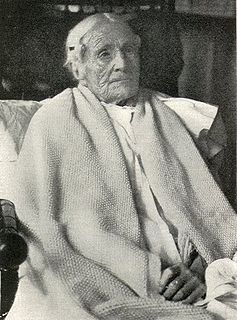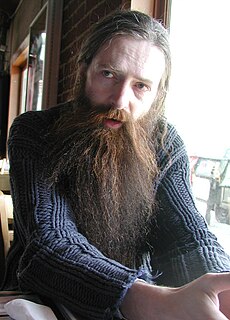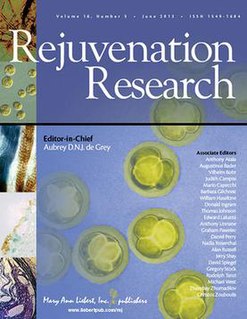
Senescence or biologicalaging is the gradual deterioration of functional characteristics. The word senescence can refer either to cellular senescence or to senescence of the whole organism. Organismal senescence involves an increase in death rates and/or a decrease in fecundity with increasing age, at least in the latter part of an organism's life cycle.
Life extension is the concept of extending the human lifespan, either modestly through improvements in medicine or dramatically by increasing the maximum lifespan beyond its generally-settled limit of 125 years.

Gerontology is the study of the social, cultural, psychological, cognitive, and biological aspects of aging. The word was coined by Ilya Ilyich Mechnikov in 1903, from the Greek γέρων, geron, "old man" and -λογία, -logia, "study of". The field is distinguished from geriatrics, which is the branch of medicine that specializes in the treatment of existing disease in older adults. Gerontologists include researchers and practitioners in the fields of biology, nursing, medicine, criminology, dentistry, social work, physical and occupational therapy, psychology, psychiatry, sociology, economics, political science, architecture, geography, pharmacy, public health, housing, and anthropology.

Aubrey David Nicholas Jasper de Grey is an English author and biomedical gerontologist. He is the Chief Science Officer of the SENS Research Foundation and VP of New Technology Discovery at AgeX Therapeutics, Inc. He is editor-in-chief of the academic journal Rejuvenation Research, author of The Mitochondrial Free Radical Theory of Aging (1999) and co-author of Ending Aging (2007). He is known for his view that medical technology may enable human beings alive today not to die from age-related causes. He is also an amateur mathematician who has contributed to the study of the Hadwiger–Nelson problem.

Biogerontology is the sub-field of gerontology concerned with the biological aging process, its evolutionary origins, and potential means to intervene in the process. It involves interdisciplinary research on the causes, effects, and mechanisms of biological aging. Biogerontologist Leonard Hayflick has said that the natural average lifespan for a human is around 92 years and, if humans not invent new approaches to treat aging, they will be stuck with this lifespan. James Vaupel has predicted that life expectancy in industrialized countries will reach 100 for children born after the year 2000. Many surveyed biogerontologists have predicted life expectancies of more than three centuries for people born after the year 2100. Other scientists, more controversially, suggest the possibility of unlimited lifespans for those currently living. For example, Aubrey de Grey offers the "tentative timeframe" that with adequate funding of research to develop interventions in aging such as Strategies for Engineered Negligible Senescence, "we have a 50/50 chance of developing technology within about 25 to 30 years from now that will, under reasonable assumptions about the rate of subsequent improvements in that technology, allow us to stop people from dying of aging at any age". The idea of this approach is to use presently available technology to extend lifespans of currently living humans long enough for future technological progress to resolve any remaining aging-related issues. This concept has been referred to as longevity escape velocity.
Biological immortality is a state in which the rate of mortality from senescence is stable or decreasing, thus decoupling it from chronological age. Various unicellular and multicellular species, including some vertebrates, achieve this state either throughout their existence or after living long enough. A biologically immortal living being can still die from means other than senescence, such as through injury, poison, disease, lack of available resources, or changes to environment.
Rejuvenation is a medical discipline focused on the practical reversal of the aging process.
Following is a list of topics related to life extension:

Rejuvenation Research is a bimonthly peer-reviewed scientific journal published by Mary Ann Liebert that covers research on rejuvenation and biogerontology. The journal was established in 1998. From 2004 till now its editor-in-chief is Aubrey de Grey. It is the official journal of the European Society of Preventive, Regenerative and Anti-Aging Medicine as well as PYRAMED: World Federation and World Institute of Preventive & Regenerative Medicine.
The following outline is provided as an overview of and topical guide to life extension:

Preston W. Estep III is an American biologist and science and technology advocate. He is a graduate of Cornell University, where he did neuroscience research, and he earned a Ph.D. in Genetics from Harvard University. He did his doctoral research in the laboratory of genomics pioneer Professor George M. Church at Harvard Medical School.

Suresh Rattan is a biogerontologist – a researcher in the field of biology of ageing, biogerontology.
Xenocatabolism is a concept in medical bioremediation that relies upon introducing into the body microbial enzymes that break down pathogenic lysosomal, cytosolic and extracellular aggregates. The term, also called xenohydrolysis, was coined by Aubrey de Grey, building upon the work of others. de Grey posited that there are microbes that feed on substances such as amyloid, cholesterol and other related substances in places that are full of human remains, such as graveyards. This was based on the microbial infallibility hypothesis. He states that "the biomedical approach would be to identify the genetic basis for that capacity, and to put one or two genes into ourselves, thereby enhancing our own ability to break things down, and to thereby get rid of things that we cannot naturally break down". In order to add credibility the concept, de Grey created an experiment using soil from a graveyard and took the bacteria from it. He used lipofuscin, "one of the major things that accumulates indigestibly in the body" – which some of the bacteria broke down, lending credibility to the hypothesis. de Grey presented this theory on May 29, 2007, at the Googleplex Google TechTalks.

An aging-associated disease is a disease that is most often seen with increasing frequency with increasing senescence. Essentially, aging-associated diseases are complications arising from senescence. Age-associated diseases are to be distinguished from the aging process itself because all adult animals age, save for a few rare exceptions, but not all adult animals experience all age-associated diseases. Aging-associated diseases do not refer to age-specific diseases, such as the childhood diseases chicken pox and measles. "Aging-associated disease" is used here to mean "diseases of the elderly". Nor should aging-associated diseases be confused with accelerated aging diseases, all of which are genetic disorders.
The Methuselah Foundation is a non-profit organization with declared mission to 'make 90 the new 50 by 2030' by supporting tissue engineering and regenerative medicine therapies. It was co-founded in 2003 by David Gobel and Aubrey de Grey. Their work includes:

David Gobel is an American philanthropist, entrepreneur, inventor, and futurist. He is co-founder and CEO of the Methuselah Foundation, CEO of the Methuselah Fund, and one of the first to publicly advance the idea of longevity escape velocity, even before this term was formulated.

Ending Aging: The Rejuvenation Breakthroughs that Could Reverse Human Aging in Our Lifetime is a 2007 book written by Aubrey de Grey, a biogerontologist, with his research assistant Michael Rae. Ending Aging describes de Grey's proposal for eliminating aging as a cause of debilitation and death in humans, and restoring the body to an indefinitely youthful state, a project plan that he calls the "Strategies for Engineered Negligible Senescence", or "SENS". De Grey argues that defeating aging is feasible, possibly within a few decades, and he outlines steps that can be taken to hasten the development of regenerative medicine treatments for each side of aging.
The anti-aging movement is a social movement devoted to eliminating or reversing aging, or reducing the effects of it. A substantial portion of the attention of the movement is on the possibilities for life extension, but there is also interest in techniques such as cosmetic surgery which ameliorate the effects of aging rather than delay or defeat it.
The societal effects of negligible senescence considers a scenario where negligible senescence is achieved on a societal wide level in humans. There is much controversy about the realistic timeline of such a scenario. The predictions vary in time starting from 2037 till later than the 21st century. The effects of negligible senescence has a profound impact on economy, climate, demographics and impacts social structures. The baseline scenario ceteris paribus of negligible senescence is more population growth while a larger healthier labor force would spur economic growth.
People were always interested how to make their lives longer and healthier in old age. Already the most anсient Egyptian, Indian and Chinese writing books contain reasoning about aging. Ancient Egyptians used garlic in large quantities to extend their lifespan. Hippocrates in his Aphorisms and Aristotle (384 – 322 BC) in On youth and old age expresses their opinions about reasons of old age and gave advices about lifestyle. Medieval Persian physician Ibn Sina, known in the West as Avicenna, summarized achievements earlier generations about this issue. Descriptions of rejuvenation and immortality remedies are often in writing of alchemists. But all those remedies did not allow even alchemists themselves to live longer than 100 years.











